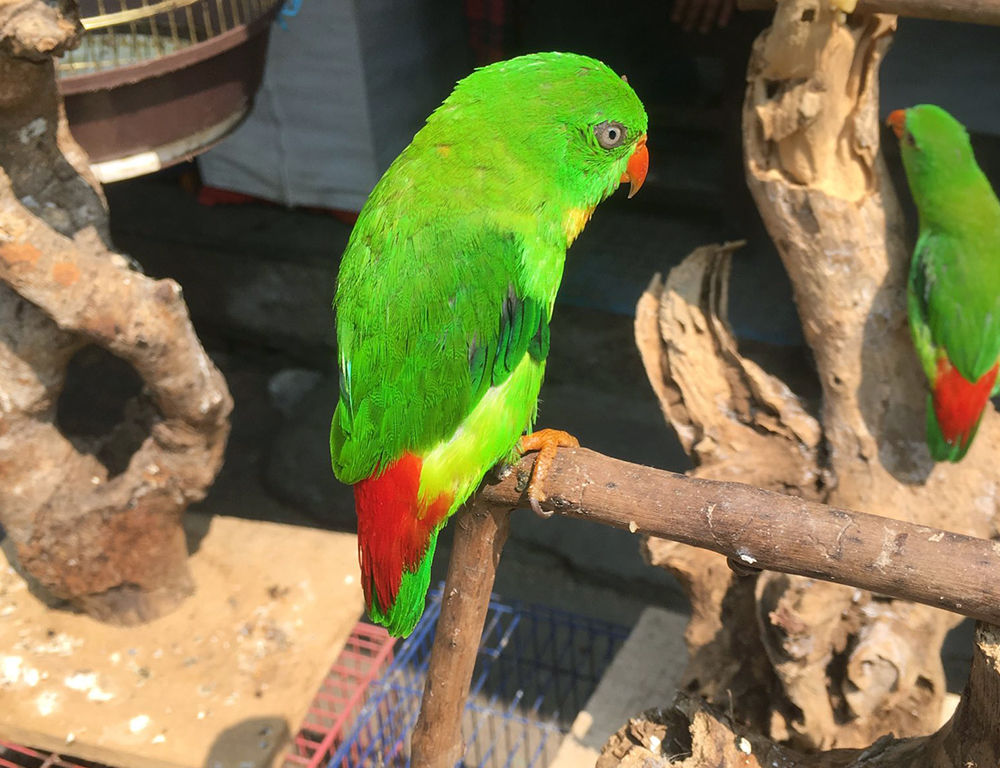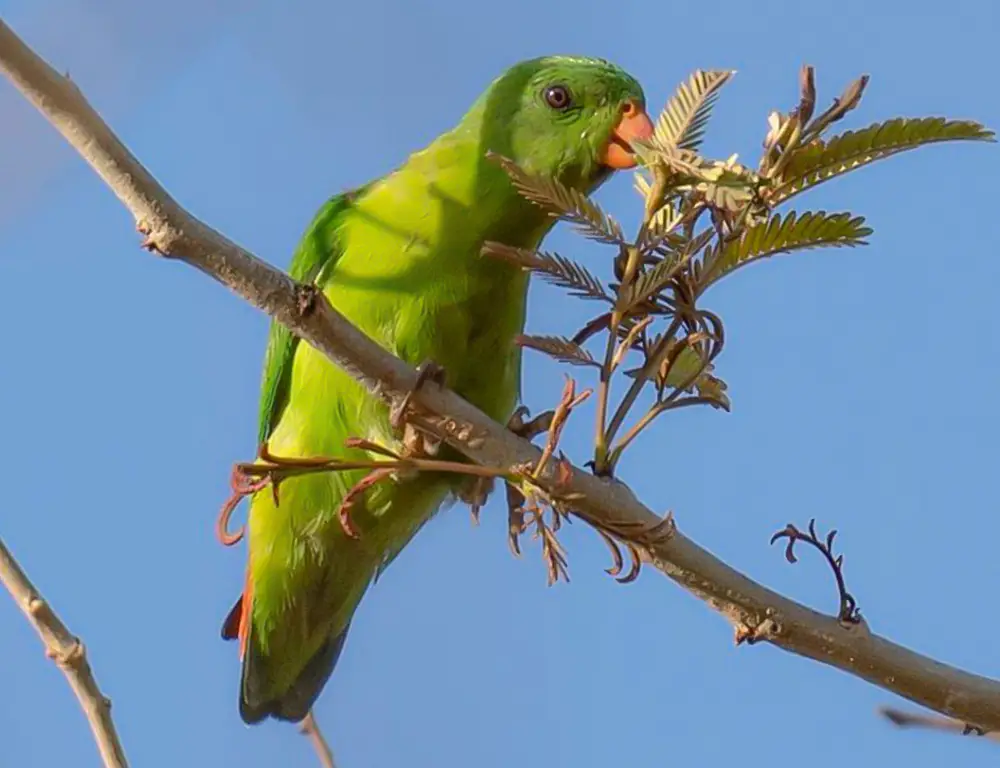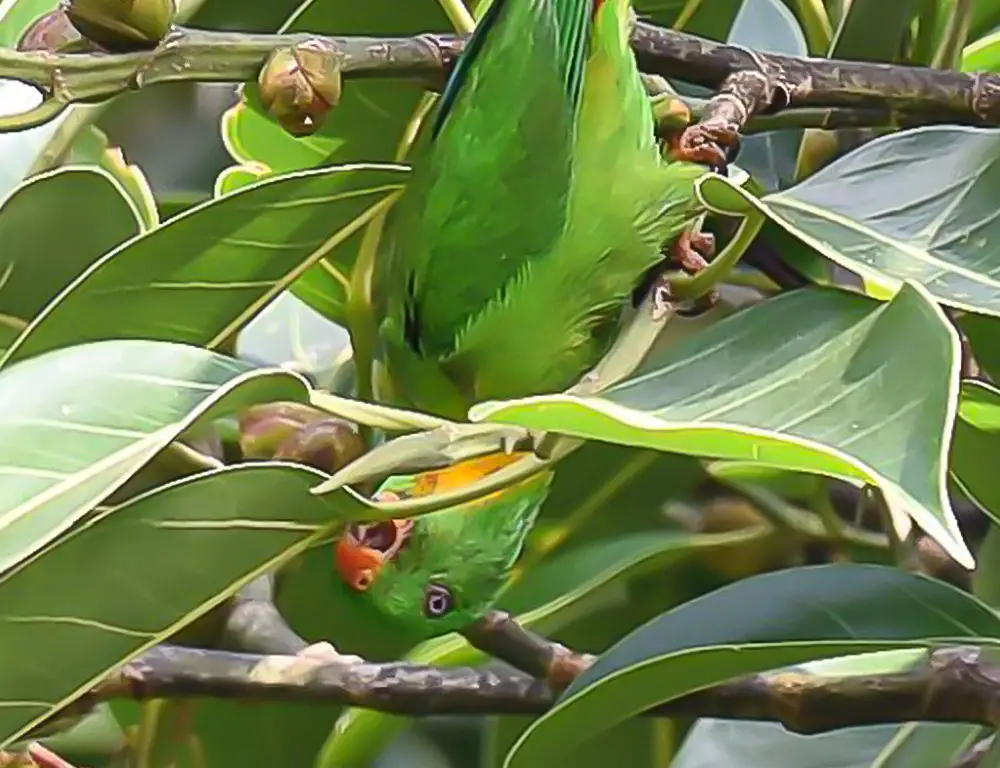In avian marvels, the Yellow-Throated Hanging Parrot emerges as a captivating species, distinguished by its vibrant hues and intriguing behaviors.
Endemic to select Southeast Asian regions, this member of the Psittaculidae family captivates observers with its radiant green plumage and distinctive yellow throat. However, what truly sets it apart is its unconventional sleeping habit—hanging upside down akin to bats.
Despite being no larger than a sparrow, these small parrots command attention with their eye-catching colors and fascinating lifestyle.
This peculiar behavioral adaptation piques curiosity and invites exploration into the complexities of bird behavior and evolutionary adaptations.
The Yellow-Throated Hanging Parrot embodies nature’s boundless wonders, captivating enthusiasts and igniting a quest for understanding its unique place in the avian world.

Physical Characteristics of Yellow-Throated Hanging Parrot
The Yellow-Throated Hanging Parrot (Loriculus pusillus) possesses a distinctive set of physical characteristics that make it easily identifiable within its habitat.
Here’s a detailed overview of its physical traits:
Size
These parrots are small in size, measuring approximately 10 to 12 centimeters (4 to 4.7 inches) in length from beak to tail. Despite their small stature, they exhibit remarkable agility and flight capabilities.
Weight
On average, yellow-troated hanging Parrots weigh around 28 to 32 grams, making them lightweight and well-suited for aerial maneuvers.
Plumage
The plumage of the Yellow-Throated Hanging Parrot is predominantly a vibrant shade of green, which provides excellent camouflage within the dense foliage of their forest habitat. Both males and females exhibit this green coloration, with males often displaying slightly brighter or more colorful plumage, particularly on the back and rump.
Throat
One of the most striking features of this parrot is its bright yellow throat, which contrasts vividly with the green plumage. The yellow throat extends from the chin to the upper chest, creating a distinct and eye-catching pattern.
Head
They have small, rounded heads with dark-colored eyes and a short, stout beak. The beak is adapted for cracking open seeds, accessing fruits, and extracting nectar from flowers.
Tail
Yellow-throated hanging Parrots have relatively short tails compared to other parrot species. The tail feathers are typically green, although some may exhibit hints of blue or different colors.
Wings
Their short and rounded wings allow quick and agile flight maneuvers within the dense forest canopy. These wings are essential for navigating through the intricate network of branches and foliage.
Legs and Feet
These parrots have sturdy legs and feet equipped with sharp claws, which enable them to grip onto branches and perches securely. Their feet are well-adapted for grasping and climbing, facilitating movement within their arboreal habitat.
Habitat and Distribution of the Yellow-Throated Hanging Parrot

The Yellow-Throated Hanging Parrot (Loriculus pusillus) is a species primarily found in specific Southeast Asian regions. Here’s a detailed look at its habitat and distribution:
Habitat
Yellow-throated hanging Parrots inhabit forested and wooded areas, particularly favoring lowland and foothill regions. They thrive in diverse habitats such as tropical rainforests, montane forests, and wooded areas adjacent to agricultural landscapes.
These parrots are well-adapted to life in the forest canopy, where they forage, roost, and nest among the branches and foliage.
Distribution
- Geographic Range: The distribution of the Yellow-Throated Hanging Parrot is relatively limited. It is primarily found within the Indo-Malayan realm, specifically endemic to certain Indonesian islands.
- Endemic Range: The species is endemic to the Indonesian islands of Java and Bali. It is not found naturally in other parts of the world. The parrots Within this restricted range are typically found in forested areas, including primary and secondary forests.
- Altitude: Yellow-throated hanging Parrots are primarily found in lowland and foothill regions but have been observed at elevations up to 1450 meters (4756 feet) above sea level.
Behavioral Adaptations
Yellow-throated hanging Parrots exhibit several behavioral adaptations that allow them to thrive in their habitat. They are adept flyers, capable of swiftly navigating through the dense forest canopy.
Their small size and green plumage provide excellent camouflage, helping them blend into their surroundings and avoid predation.
Their unique roosting behavior, such as hanging upside down, further demonstrates their adaptation to life in the treetops.
Challenges in Spotting
Due to their small size, cryptic coloration, and the dense vegetation of their habitat, spotting Yellow-Throated Hanging Parrots can be challenging.
However, their distinctive calls and behavior, such as hanging upside down while roosting, may aid in locating them within the forest canopy.
Diet and Feeding Habits of the Yellow-Throated Hanging Parrot

The Yellow-Throated Hanging Parrot has a diverse diet and interesting feeding habits that contribute to its survival. Here’s a closer look at their diet and feeding behaviors:
Diet
- Fruits: Fruits comprise a significant portion of the Yellow-Throated Hanging Parrot’s diet. They are avid fruit consumers and feed on various fruits, including small berries, figs, wild guavas, durians, and rambutans. These fruits provide essential nutrients and energy for their daily activities.
- Flowers and Nectar: Besides fruits, these parrots consume flowers and nectar. They are particularly fond of flowers with high nectar content, such as those from eucalyptus trees. Nectar serves as a source of carbohydrates and supplements their diet with additional nutrients.
- Seeds: Seeds are another component of their diet, providing essential fats and proteins. While they may not be their primary food source, Yellow-Throated Hanging Parrots will consume seeds when available.
- Insects: Although primarily frugivorous, Yellow-Throated Hanging Parrots have occasionally been observed feeding on insects. Insects serve as a valuable source of protein, especially during breeding seasons or when fruit availability is scarce.
Feeding Habits
- Upside-Down Feeding: One of the most remarkable feeding behaviors of the Yellow-Throated Hanging Parrot is its ability to feed while hanging upside down. This unique technique allows them to access food sources inaccessible to other birds and increases their foraging efficiency.
- Social Feeding: These parrots often feed in small groups, especially when abundant food sources are available. Observing a fruit-filled tree can reveal a flurry of activity as multiple parrots gather to feed together. Social feeding allows them to find food more efficiently and promotes social interactions within the flock.
- Timing of Feeding: Unlike many other bird species that forage during dawn or dusk, Yellow-Throated Hanging Parrots prefer to feed midday when temperatures are warmer. This unique feeding schedule may help them avoid competition with other active bird species during different times of the day.
Breeding and Reproduction Habits of the Yellow-Throated Hanging Parrot
The breeding and reproduction behaviors of the Yellow-Throated Hanging Parrot are fascinating and involve several notable characteristics:
Monogamous Pairing
Yellow-throated hanging Parrots are monogamous, meaning that pairs form long-term bonds and mate for life. This behavior ensures stability and cooperation between breeding partners throughout the reproductive process.
Nesting
- Selection of Nesting Site: The female selects a suitable nesting site, often choosing a tree cavity or a hole in an old tree trunk. Bamboo stalks may also serve as nesting sites. The chosen location provides protection and security for nesting activities.
- Nest Building: Once a nesting site is selected, the female initiates nest construction by lining the cavity with fresh leaves. This lining helps create a comfortable and insulated environment for incubating eggs and raising chicks.
Egg-Laying and Incubation
- Clutch Size: Yellow-throated hanging Parrots typically lay clutches of two eggs. These eggs are small and oval-shaped, adapted to fit within the limited space of the nesting cavity.
- Incubation Period: The male and female share incubation duties, keeping the eggs warm and protected. The incubation lasts approximately 20 days, during which the parents diligently attend to the eggs’ needs.
Parental Care
- Feeding Chicks: After hatching, the parents continue to work together to care for the chicks. They feed their offspring a regurgitated mixture of food, providing essential nutrients for growth and development.
- Fledging: Chicks remain in the nest for about five weeks before fledging. During this time, they gradually develop their flight feathers and motor skills under the watchful eyes of their parents.
Breeding Frequency
Yellow-throated hanging Parrots typically breed once a year, although favorable conditions may lead to breeding attempts occurring twice within a single breeding season.
Environmental factors such as food availability and climate conditions influence breeding frequency and reproductive success.
Conservation Status of the Yellow-Throated Hanging Parrot
The conservation status of the Yellow-Throated Hanging Parrot is a cause for concern, as it is currently classified as “Near Threatened” on the International Union for Conservation of Nature (IUCN) Red List.
Here are some key points regarding their conservation status and the factors contributing to it:
Current Status
The Yellow-Throated Hanging Parrot’s population has declined steadily over the years, primarily due to habitat loss and illegal pet trade. As of recent assessments, their population is estimated to be less than 10,000 individuals.
To give you a better idea of its numbers, here’s a table representing the estimated population trend over recent years:
| Year | Estimated Population |
|---|---|
| 2010 | 10,000-20,000 |
| 2015 | 8,000-15,000 |
| 2020 | less than 10,000 |
Major Threats
- Habitat Loss: Deforestation, primarily driven by the expansion of agricultural activities such as palm oil plantations and logging, has resulted in the loss and fragmentation of their natural habitat. This habitat loss deprives the parrots of suitable nesting sites, foraging areas, and roosting sites.
- Illegal Pet Trade: The Yellow-Throated Hanging Parrot’s vibrant colors and unique behaviors make it a target for illicit wildlife trade. These birds are captured from the wild and sold as pets in local and international markets, further reducing their wild populations.
Conservation Efforts
Efforts to conserve the Yellow-Throated Hanging Parrot focus on mitigating its threats and promoting long-term survival. Some conservation initiatives include:
- Habitat Protection: Implementing measures to protect and preserve the remaining forested areas within the parrot’s range is essential for maintaining viable populations. This may involve establishing protected areas, promoting sustainable forestry practices, and reforestation efforts.
- Law Enforcement: Strengthening enforcement of laws and regulations against illegal wildlife trade is crucial for reducing the capture and trafficking of yellow-troated Hanging Parrots.
This may include increasing patrols, implementing stricter penalties for offenders, and raising awareness about the consequences of wildlife trafficking. - Community Engagement: Engaging local communities in conservation efforts can help foster a sense of stewardship and encourage sustainable practices that benefit both people and wildlife.
This may involve education and outreach programs, providing alternative livelihood options, and involving communities in habitat restoration projects.
Research and Monitoring
Continued research and monitoring efforts are necessary to understand better the Yellow-Throated Hanging Parrot’s ecology, behavior, and population trends.
This information can inform conservation strategies and help guide management decisions aimed at safeguarding the species.
Conclusion
The Yellow-Throated Hanging Parrot is a remarkable bird species because of its unique physical attributes and significant ecological contributions. Its vibrant yellow throat and swift flying abilities make it a captivating specimen in ornithology.
Furthermore, its role in seed dispersion through its diet of fruits and seeds underscores its importance in forest growth and ecosystem dynamics. However, the challenges it faces, particularly habitat loss due to deforestation, threaten its survival.
Conservation efforts, including raising awareness, preserving natural habitats, and implementing legal protections, are essential for ensuring the continued existence of this species.
As stewards of the planet, we are responsible for safeguarding these lively creatures for future generations, recognizing their invaluable role in enriching our world’s biodiversity.